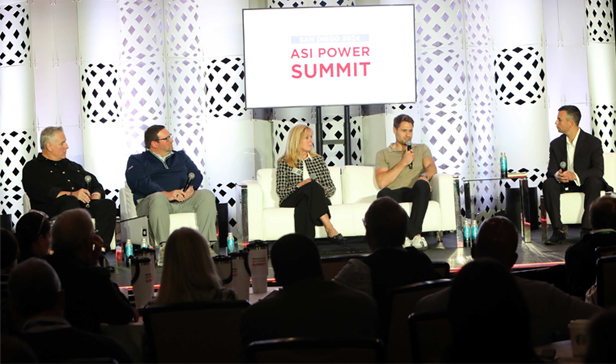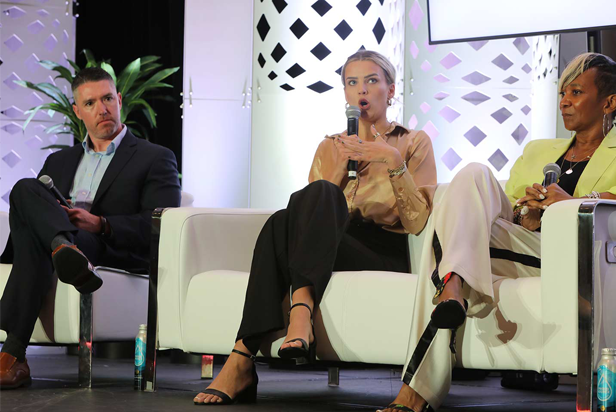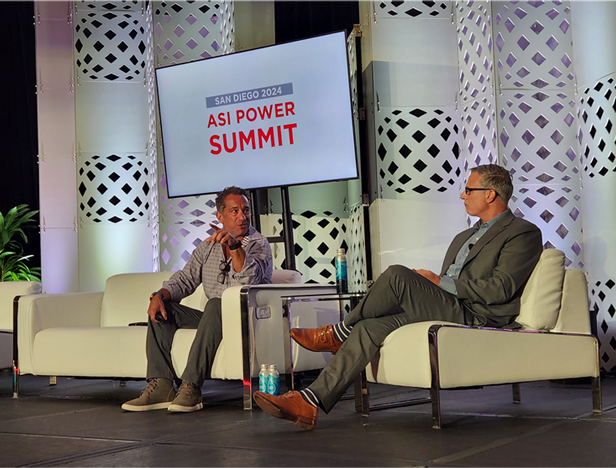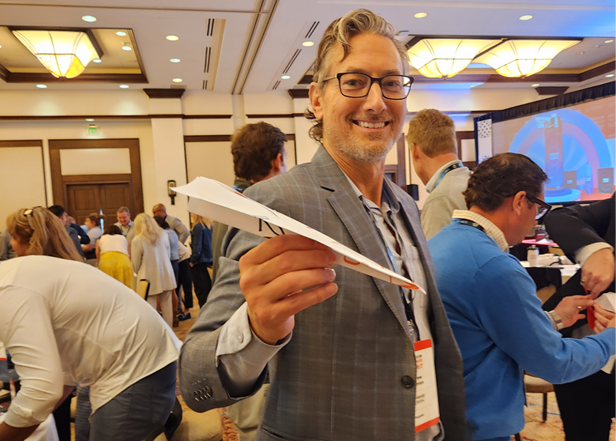News October 15, 2024
ASI Power Summit 2024: Day 1 & 2 Wrap-Up
The information-packed day included sessions on promo’s top issues, AI and what end-buyers want.
Key Takeaways:
• AI’s Transformative Impact: AI tools can drastically improve efficiency in business processes and labor-intensive tasks like creating client presentations.
• Promo Industry Challenges and Solutions: A panel of industry leaders discussed major issues, such as rising costs, cybersecurity and the RFP process.
• Diverse Discussions: The ASI Power Summit tackled a range of topics, including staff succession, sticky marketing trends and end-buyer motivations.
The ASI Power Summit is going full tilt. The first two days of the event that brings together the leaders of the promotional products industry delivered fascinating sessions, thought-provoking information and energetic networking. The event, taking place this year at the Rancho Bernardo Inn in San Diego, CA, from October 13-15, began with a networking reception and dinner on Sunday night followed the next day by several top-tier educational sessions. Political leaders Donna Brazile and Will Hurd riveted the crowd with their inside look at this year’s election, and economist Mary Kelly explored the state of the economy and how it’s impacting businesses. Later in the evening, ASI revealed the Counselor Power 50 at the annual Power 50 dinner. Day 3 of the conference continues today with a quartet of highly anticipated panels and talks.
Here’s a look at several of the sessions and activities from the first two days of the ASI Power Summit.
Startling Possibilities With the AI Revolution
From three days down to about 30 minutes. That, said Isar Meitis, is the type of efficiency you can gain when using an artificial intelligence platform like ChatGPT savvily to create fully realized, deftly tailored client presentations.
It was just one of the eye-popping examples Meitis offered on how promo pros can start leveraging currently available AI tools to bolster their businesses.
Isar Meitis, CEO of Multiplai, discusses the radical ways AI is already impacting business – and what’s to come.
Meitis, an AI implementation expert and CEO of Multiplai, also discussed strategies for working with AI to map business processes, generate high-quality leads and swiftly create videos in a vast array of languages using a digital doppelgänger.
As companies look to venture forward with AI, it’s pivotally important to have a plan in place, Meitis said. He maintained that this should include committing to continuous education on AI, forming an AI committee and, critically, establishing AI policies and ethical guidelines.
Meitis also offered a no-holds-barred look at the rapid advancements being made with AI and what they could mean for businesses over the next two to three years, from humanoid robots populating warehouses to the development of artificial general intelligence that will, among many other things, be able to create marketing plans and ideas nearly instantaneously for “free.”
Meitis wasn’t trying to scare folks. He was encouraging everyone to consider the future and adapt. “This change is happening faster than any other in business history,” Meitis told ASI Media in conversation after his talk. “We can stick our heads in the sand and try to ignore it, or we can learn and evolve with it.”
Tackling Promo’s Biggest Challenges
A panel of promo industry leaders delved into some of the most pressing issues the branded merchandise industry is facing.
Hosted by ASI Media Editor-in-Chief C.J. Mittica, the panel featured Mitch Freed, CEO of Counselor Top 40 distributor Genumark (asi/204588); Kevin Pollack, chief operating officer of Counselor Top 40 distributor HALO Branded Solutions (asi/356000); Mary Dobsch, president of supplier The Chest (asi/44830); and Jamie Mair, CEO/owner of distributor Capsule & Kitsch (asi/157354).

A panel of promo experts (from left to right, Jamie Mair, Kevin Pollack, Mary Dobsch and Mitch Freed) discussed some of the most significant issues facing the promo industry.
Topics covered included the rising cost of business, increasing requirements from large clients, cybersecurity and supply chain. Still, the session wasn’t about bemoaning problems; it was about looking at potential solutions.
Take cybersecurity: Panelists acknowledged that it’s become a huge concern and that large portions of their information technology budgets go toward bulwarking their businesses against such attacks. While nothing is necessarily foolproof, the panelists did share that, through proper employee training and consistent evolution of systems to account for potential vulnerabilities, businesses can greatly increase their chances of fending off an attack. It’s possible for small and midsized companies, too.
“Even if you’re a smaller distributor, there are folks who can guide you on the journey,” Pollack said. “Talk to the experts who know about this.”
Panelists also discussed sales impediments, including the frustrations of the RFP (request for proposal) process. Too often it’s driven by procurement departments, rather than the marketers who require merch for particular campaigns and initiatives. Panelists suggested having more direct interaction with the actual end-clients, and making the focus less about checking certain boxes and more about zeroing in on finely honed, unique solutions. Instead of a request for proposal, said Mair, “it should be a request for a solution.”
End-Buyers Share What Matters to Their Generations
What do buyers want? Distributors have spent thousands of hours pondering that question. Well, three end-buyers of different generations took the stage, along with ASI Executive Editor Christopher Ruvo, to explain what they look for in distributors and what motivates their purchasing decisions.

(From left to right) End-buyers Ian Harrison of WWE, Gillian Gleason of Buyers Edge Platform and Yvette Duncan of Bravado discussed what informs their promo purchasing decisions.
Gillian Gleason, brand marketing manager of Buyers Edge Platform and a member of Gen Z, said people her age want things that are aesthetically pleasing. Big logos are phasing out, she added, and she gravitates toward monochromatic items with subtle branding. “I think it’s important to work with companies that do what they say they’re actually doing,” she said about companies when it comes to sustainability.
Ian Garrison, senior director of product development & buying for WWE and a millennial, says people value products that have everyday use, such as drinkware. Selling a story and adding value will incentivize people to buy branded products, he added. And when it comes to establishing trust with distributors? “I don’t think it’s so much the first orders. It’s the other orders where my back’s against the wall and I need a favor,” he said.
Yvette Duncan is the senior manager of product development for Bravado and Universal Music Group. A Gen Xer, she works with musical acts. Sustainability (recycled fabric and water usage) is important and flashier looks sell better. When it comes to what matters with a purchasing decision, “I would say price would be the driving factor,” she said.
ASI Exclusive Data Reveals What End-Buyers Want
Get this: 68% of end-buyers from companies of all sizes say that promotional products are “very important” to their marketing strategy. That was one of the more heartening takeaways from “By the Numbers: Exclusive Demographic-Driven End-Buyer Data.”
Nate Kucsma, ASI’s senior executive director of research, and Michele Bell, senior vice president of content and global alliances, led the education session that spotlighted exclusive data ASI has compiled on promo purchasers. The data took into account elements like different ages, geographic regions and company sizes to assess the preferences of merch buyers.
There was no shortage of interesting findings. For instance, 37% of all buyers plan to increase their investment in branded merchandise in 2024, while 58% expect to maintain current spend levels. Meanwhile, the study found that quality (90% of respondents) and price (81%) were the top two considerations end-buyers take into account when weighing a promotional product purchase.
69%
of end-buyers under the age of 35 consider environmental impact when purchasing promo.(ASI Research)
Interestingly, the youngest end-buyers – those 35 and below – gave the least credence to price, with only 69% of that age cohort stating it’s a consideration. Meanwhile, 92% of those 55 years and older, 78% of people ages 45 to 54 and 82% of end-buyers in the 35-to-44-year-old range said price is a top factor for them.
“Understanding what end-buyers are looking for is a vital part of understanding how to grow your business,” said Kucsma. “If you understand what’s important to them, what products they are likely to be looking for and what they want from you as a business partner, you will have a step up on your competition. That’s what our research aims to provide.”
Sticky Marketing Trends That Work
What are some of the hottest trends in marketing right now? Les Kollegian, CEO and Chief Creative Officer of the Jacob Tyler Brand + Digital Agency, took the stage to lay out five ways to create “sticky marketing.”

Les Kollegian (left), CEO and chief creative officer of the Jacob Tyler Brand + Digital Agency, along with ASI Executive Creative Director Jake Krolick, discussed hot marketing trends.
All of the strategies relied on digital technology in different ways. Augmented reality allows for three-dimensional products and the ability to put them into different environments. Mobile searches have drastically increased, said Kollegian, making this technology a natural fit. “We’re starting to see companies that have the engineers to make it relatively inexpensive for us to use and test monthly,” said Kollegian, who at one time was a registered ASI distributor.
Kollegian who presented alongside ASI Executive Creative Director Jake Krolick, ticked off a number of other trends, including dynamic personalization, branded search and landing page conversion optimization. Voice and conversational marketing are especially hot right now. Chatbots can be purchased and trained for a specific industry, company information and product. “A lot of times what people do is they think that they can just blow their whole customer service team off and replace it with [a chatbot],” Kollegian said. “Do not do that. Just use it as an assist that can save time and create a happier customer experience.”
Making Staff Succession a Top Priority
Only 30% of companies are actively planning staff succession – the act of finding and preparing replacements if a leader or executive moves on. It seems shockingly low for such an important avenue of maintaining continuity and success. Author, podcaster and entrepreneur Jeff Butler, the CEO of TrinityFix, laid out concrete steps for businesses to have a process in place to erase that gap.
Author and entrepreneur Jeff Butler discusses what steps promo businesses can take to start prioritizing staff succession.
Typically, companies will look at the direct reports of the person who’s leaving for a replacement. “When you have one-on-ones with [these direct reports],” said Butler, “you typically find not only what do they do well and not well, but why they’re there. You see what keeps them at their job. And that gives you a much stronger pulse of what’s going on.”
Butler, who gave the session with ASI Vice President Stephanie Cohn Schaeffer, said the first step is to map out your timeline to identify replacements – up to nine months for individual contributors, and anywhere from 12-36 months for director-level positions.
Next, companies need to identify the necessary core competencies and then assign a learning path to add those new skills or responsibilities. After that, Butler said companies should evaluate their bench and figure out who can be suited for the new role and how long it will take them to be ready. If people are happy and locked into their current roles and there’s no one on the bench to be that replacement, that’s when you look outside the company for that external hire.
Butler’s final piece of advice? “See it as an opportunity, not as a liability,” he concluded, “because it’s your time to actually upgrade that position.”
Networking & Paper Airplane-Building

Andrew Spellman, VP of corporate markets at Therabody (asi/91104), shows off his paper airplane-making skills during the day’s team-building activity.
This year’s ASI Power Summit offered attendees multiple chances to network and collaborate. During a networking break, cards featuring provocative questions about the industry allowed attendees at each table to discuss their biggest challenges and come up with solutions together. And the end of the day concluded with a team-building exercise where groups built paper airplanes and competed to see whose planes could fly the farthest and stay in the air the longest. ASI donated $2,500 for the winning teams to the American Red Cross to help the victims of Hurricane Helene.
